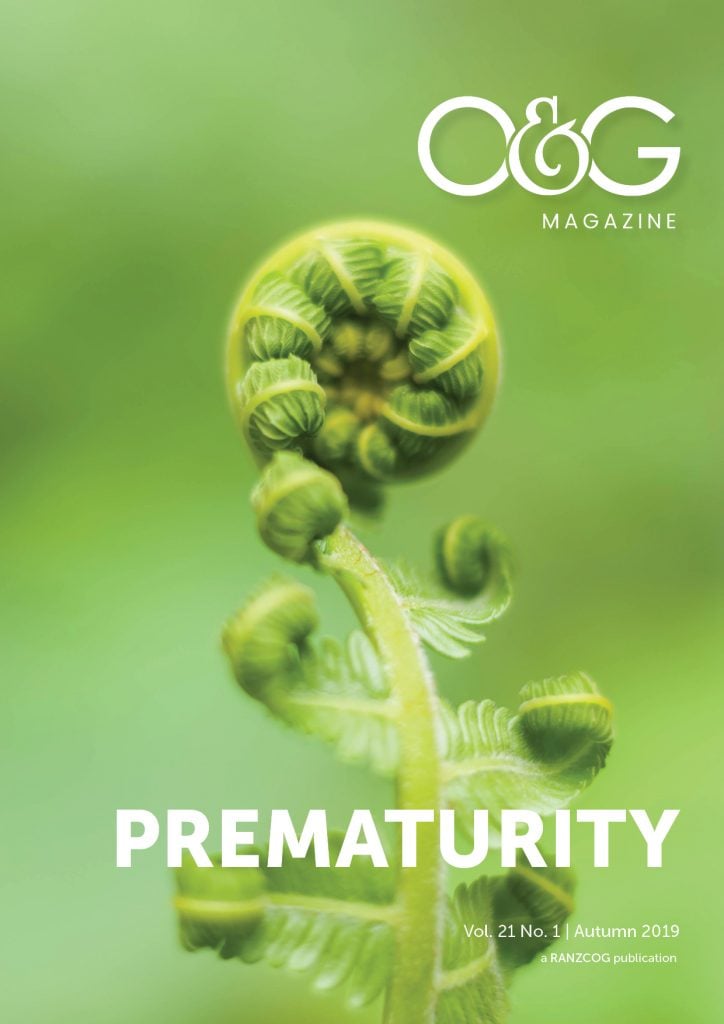Preterm birth (PTB) is the leading cause of morbidity and mortality in the developed world and affects 5–18 per cent of births globally. Spontaneous preterm labour (PTL) is the cause of 40–50 per cent of total preterm births with a further 20–30 per cent due to premature rupture of membranes (PROM) precipitating labour. The remaining 20–30 per cent of births are clinician initiated, due to maternal or fetal issues that complicate the pregnancy.
Spontaneous preterm birth is hypothesised to be via one of the following four pathways:
- Premature activation of the maternal or fetal hypothalamic-pituitary-adrenal axis
- Exaggerated inflammatory response or infection
- Decidual haemorrhage
- Pathological uterine distention
The purpose of this article is to review the risk factors that clinicians should be aware of, and screen for, preconception or early in antenatal care.
Reproductive factors
History of previous spontaneous preterm birth
This is the major risk factor for recurrence of PTB (15–30 per cent) and often recurrence at the same or earlier gestation.1
The women who are deemed to be at highest risk are those with:
- No term pregnancy between the previous spontaneous PTB and the current pregnancy
- A history of multiple spontaneous PTBs
Short cervix
There is an inverse relationship between cervical length measured by transvaginal ultrasound at 16–28 weeks of gestation and gestational age at delivery. Cervical shortening (effacement) is one of the first steps in the processes leading to labour and can precede labour by several weeks.2 Effacement begins at the internal cervical os and progresses caudally; thus, it can often be detected on ultrasound examination before it can be appreciated on physical examination. All women with a singleton birth should have a request to screen for cervical length as part of the anatomy scan. Clinicians should keep in mind the measurements of less than 35 mm transabdominally and less than 25 mm transvaginally as the limits that may warrant further intervention. For women with a previous preterm birth, the recommendation is that cervical length screening should start earlier.
Uterine abnormalities
Congenital uterine abnormalities and acquired abnormalities, such as fibroids, can result in PTB. Depending on the type and severity, they should be addressed preconception.
Uterine instrumentation and cervical surgery
A systematic review of almost one million women showed that women with a history of surgical evacuation for miscarriage or termination of pregnancy have a small, but statistically significant, increased risk of PTB in a subsequent pregnancy, compared with controls (5 versus 5.7 per cent).3
The new cervical screening test program is aimed at decreasing cervical surgery for low-risk women and the effects on their reproductive outcomes. Both cone biopsy and LLETZ procedures effect the integrity of the cervix, although the cervix is better preserved following ablation versus excision procedures. It is hypothesised that these treatments impact the cervical glands and stroma, affecting cervical mucous production and the collagen matrix, impairing cervical stroma and tensile strength. There is mixed data on the effect of LLETZ procedures on subsequent preterm birth; however, cone biopsy is associated with PTB in gestations of less than 28 weeks.
Assisted reproduction
Pregnancies conceived by artificial reproductive treatment (ART) have up to two-fold increased risk of PTB, even accounting for those affected by multifetal gestation. This increased risk is believed to be a direct result of the baseline maternal factors necessitating the couple to undergo ART.4
Maternal factors
Maternal medical issues
Chronic maternal medical disorders are frequently associated with maternal or fetal complications causing medically indicated PTB as well as an increased risk for spontaneous PTB. Examples frequently encountered include hypertension, renal insufficiency, severe respiratory disease, type 1 diabetes mellitus, autoimmune diseases, organ transplantation and severe pre-eclampsia.
Age
Similar to many other obstetric complications, extremes of maternal age place the women at risk of PTB.5 The average age in Australia of first pregnancy is now over 30 and this is increasing every year.
Genetic factors
Although certain PTB genomes have been identified, this is still an area of much ongoing research. Epigenetic and environmental factors also appear
to play a role.
Asymptomatic bacturia
It remains unclear if asymptomatic bacturia is an independent risk factor to increase a women’s chance of PTB. What is known, however, is that treating positive urinary cultures lowers the risk of a women developing pyelonephritis.6 It is recommended that all women have a urine sample sent to be screened in first trimester and those women who are at risk of recurrent infections (such as diabetics, autoimmune disease) should be offered further screening throughout the remainder of pregnancy.
Genital tract infections
Multiple studies have reported an association between preterm labour/delivery with various bacterial genital tract infections including, group B streptococci (GBS) Chlamydia trachomatis bacterial vaginosis, Neisseria gonorrhoea syphilis, Trichomonas vaginalis Ureaplasma and unencapsulated Haemophilus influenzae. The causal relationship for genital infections and PTB is controversial; however, a positive culture in pregnancy correlates with the presence of histologic chorioamnionitis on postpartum examinations.7 The current advice is to treat these infections if positive on swabs, although universal screening in the mid-trimester remains controversial with some studies showing benefit and others none.8
Current malaria infection causes PTB and this is an important risk factor which should be screened for in the group of women who may have recently travelled to, or migrated from, endemic areas.
Lifestyle and behaviour factors
Nutrition and weight
Women with better nutritional intake and healthy weight gain are less likely to have either spontaneous or iatrogenic preterm birth. Ideally, those women who fall in a range of unhealthy maternal weight should be optimised preconception. Extremes of weight and nutrition in pregnancy are often confounded by lower socioeconomic status and this may be an opportunity to provide extra support.6
Smoking
Smoking is clearly identified to place a women at risk of preterm birth. All women should be screened for cigarette smoking and offered support for smoking cessation.
Interpregnancy interval
Recommending women to space pregnancy intervals to at least 18 months and providing affordable access to effective contraception immediately postpartum has been shown to decrease the risk of subsequent PTB.9
Exercise
Exercise and its effect on pregnancy has been the subject of much research in recent years. Exercising in pregnancy has been shown to be protective in lowering rates of PTB and this is attributed to the exerciser effect (that is, healthy women who are at less risk of preterm birth are more likely to continue to exercise in pregnancy).10
Stress
Most women report at least one stressful event in the 12 months preceding birth. While it can be postulated by one of the aforementioned pathways that stress could precipitate PTB, the evidence does not consistently support stress as a strong risk factor for preterm birth. Clinicians should continue to counsel and support women experiencing high levels of stress in the pregnancy to enhance their overall health during both the pregnancy and postpartum period.
Fetal/placental factors
Multifetal gestation
May be related to increased uterine distention as well as increased sex steroid production contributing to PTB.
Polyhydramnios
Related to increased uterine distension.
Bleeding in early pregnancy
The association of first-trimester bleeding with preterm delivery before 34 weeks is related to either decidual haemorrhage causing rupture of membranes and PTB or iatrogenic resulting from of placental disease including PET, abruption, intrauterine growth restriction.11 Women with persistent vaginal bleeding and bleeding in the second trimester are at higher risk of these complications than those with an isolated first-trimester event.
Biomarkers
There is much ongoing research in this field with more than 30 biomarkers currently listed in the literature. Fetal fibronectin (fFN) is available across most birth suites in Australia and NZ.
Quantitative fFN is not useful in predicting PTB in asymptomatic nulliparous women. It does however have a role in helping predict which symptomatic women may be risk of PTB when combined with the clinical presentation (contractions, effacement and dilatation) and ultrasound assessment of cervix. fFN is now incorporated as part of the QuiPP app (including cervical length, demographic information, obstetric history) to give a risk assessment for PTB within seven days.12
References
- Laughon SK, Albert PS, Leishear K, Mendola P. The NICHD Consecutive Pregnancies Study: recurrent preterm delivery by subtype. American Journal of Obstetrics and Gynecology. 2014;210(2):131:e1-8.
- Iams JD, Goldenberg RL, Meis PJ, et al. The length of the cervix and the risk of spontaneous premature delivery. National Institute of Child Health and Human Development Maternal Fetal Medicine Unit Network. New England Journal of Medicine. 1996;334(9):567-72.
- Saccone G, Perriera L, Berghella V. Prior uterine evacuation of pregnancy as independent risk factor for preterm birth: a systematic review and metaanalysis. American Journal of Obstetrics and Gynecology. 2016;214(5):572-91.
- Jackson RA, Gibson KA, Wu YW, Croughan MS. Perinatal outcomes in singletons following in vitro fertilization: a meta-analysis. Obstetrics and Gynecology. 2004;103(3):551-63.
- Fuchs F, Monet B, Ducruet T, et al. Effect of maternal age on the risk of preterm birth: A large cohort study. PloS One. 2018;13(1):e0191002.
- Meis PJ, Michielutte R, Peters TJ, et al. Factors associated with preterm birth in Cardiff, Wales. Univariable and multivariable analysis. American Journal of Obstetrics and Gynecology. 1995;173(2):590-6.
- Klein LL, Gibbs RS. Use of microbial cultures and antibiotics in the prevention of infection-associated preterm birth. American Journal of Obstetrics and Gynecology. 2004;190(6):1493-502.
- Klein LL, Gibbs RS. Use of microbial cultures and antibiotics in the prevention of infection-associated preterm birth. American Journal of Obstetrics and Gynecology. 2004;190(6):1493-502.
- Rodriguez MI, Chang R, Thiel de Bocanegra H. The impact of postpartum contraception on reducing preterm birth: findings from California. American Journal of Obstetrics and Gynecology. 2015;213(5):703:e1-6.
- Di Mascio D, Magro-Malosso ER, Saccone G, et al. Exercise during pregnancy in normal-weight women and risk of preterm birth: a systematic review and meta-analysis of randomized controlled trials. American Journal of Obstetrics and Gynecology. 2016;215(5):561-71.
- Szymusik I, Bartnik P, Wypych K, et al. The association of first trimester bleeding with preterm delivery. Journal of Perinatal Medicine. 2015;43(5):525-9.
- Kuhrt K, Smout E, Hezelgrave N, et al. Development and validation of a tool incorporating cervical length and quantitative fetal fibronectin to predict spontaneous preterm birth in asymptomatic high-risk women. Ultrasound in Obstetrics and Gynecology. 2016;47(1):104-9.







Leave a Reply